- Transistor can be used as automatic switches.
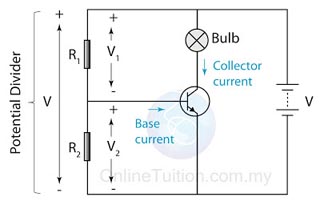
- In the diagram above, the bulb is off when the collector current is off or very small. It is switched on when the collector current become large.
- We have learned that in a transistor, the collector current is controlled by the base current, or the base voltage.
- The greater the base voltage is, the greater the base current, and hence the greater the collector current.
- Therefore the bulb can be switched on and off by varying the voltage supplied to the base.
- The voltage across the base can be controlled a potential divider.
- According to the potential divider rule, the voltages across the resistor R1 and R2 are given by the following equations:

- Therefore, by varying the resistance of R1 and R2, we can control the voltage across the base V2, and hence switch the bulb on and off.
The LDR
- A light-dependent resistor (LDR), or photoresistor, is a resistor sensitive to light.
- In darkness, the LDR has a resistance about 1 million Ohm.
- In bright light however, the resistance of the LDR falls to only a few hundred Ohms.
Light Operating Switch
- In a light operating switch, we connect an LDR to the potential divider.
- As a result, the voltage across the base vary according to the presence or absence of light.
- Example 1 and 2 below shows how the resistance of the LDR, the base voltage, the base current and the collector current change in different conditions.
Example 1
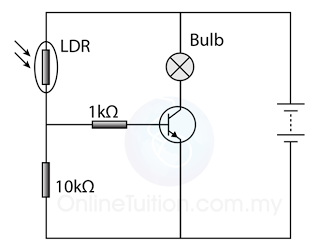
Conclusion
The bulb will be switched on when the surrounding is bright and switched off when the surrounding is dark.

| Bright Surrounding: Resistance of LDR: Low Base voltage: High Base current: High Collector current: High Bulb: ON |
Dark Surrounding Resistance of LDR: High Base voltage: Low Base current: Low Collector current: Low Bulb: OFF |
Conclusion
The bulb will be switched on when the surrounding is bright and switched off when the surrounding is dark.
Example 2
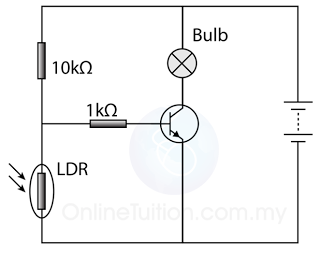
Conclusion
The bulb will be switched on when the surrounding is dark and switched off when the surrounding is bright.

| Bright Surrounding: Resistance of LDR: Low Base voltage: Low Base current: Low Collector current: Low Bulb: OFF |
Dark Surrounding Resistance of LDR: High Base voltage: High Base current: Low Collector current: High Base current: ON |
Conclusion
The bulb will be switched on when the surrounding is dark and switched off when the surrounding is bright.
Thermistor
- In a heat operated switch, the LDR is replaced by a thermistor.
- A thermistor is a resistor which its resistance changes as the temperature changes.
- There are 2 types of thermistor:
- The positive temperature coefficient (PTC) thermistor
- The negative temperature coefficient (NTC) thermistor
- For the PTC thermistor, the resistance of the thermistor increases as the temperature increases whereas for the NTC thermistor, the resistance of the thermistor decreases as the temperature increases.
- In SPM, we assume all the thermistor used is the NTC thermistor, unless it is stated otherwise.
Heat Operated Switch
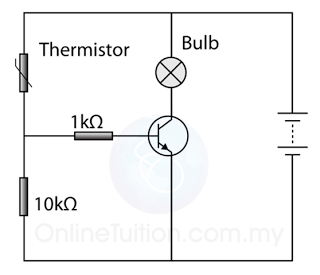
- The circuit of a heat operated switch is similar to the light operated switch, except that the LDR is replaced by an NTC thermistor.
- If heat is applied to the thermistor, its resistance drops. As a result, the base voltage will increase and the transistor is switched on and the bulb lights.
Sound Controlled Switch
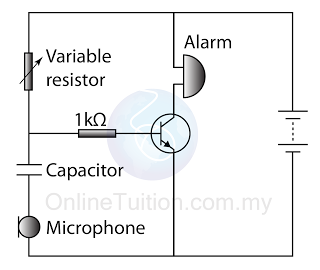
- Figure above shows the circuit design of a sound controlled switch.
- The microphone is used to convert sound to electric current.
- The variable resistor is adjusted as such that the transistor is switched on when sound is detected by the microphone.
- The function of the capacitor is to prevent the direct current from the cell to flow in the base circuit.